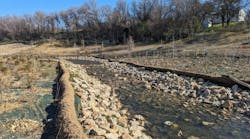Kevin Smith, owner and operator of Always Green in Coventry, RI, notes that client education, quality products, and state-of-the art equipment has put his company to where it is today. His is one of a few Rhode Island companies specializing in hydroseeding for the residential and smaller commercial markets and services the entire state. “There aren’t many companies that specialize in hydroseeding around here because they wouldn’t have enough work to stay busy unless they’re bidding on every single job,” notes Smith. Always Green provides services in hydroseeding, lawn renovations, power raking, and erosion control. Being a small business amplifies the need for top-of-the-line equipment and products because there is no wiggle room for downtime. Smith favors a one-step process of hydroseeding in which he applies grass seed, fertilizer, a wood fiber hydromulch, tackifiers, and any other additives needed such as herbicides, growth stimulants, fungicides, liquid calcium complex, or whatever else a soil test mandates. Smith uses a 1,200-gallon FINN HydroSeeder with paddle agitation. “There are no limitations with this machine,” he says. “We can spray out the biggest slurries using 100% wood fiber mulch because of the paddle agitation.” He also likes using Flexterra from Profile Products. “It’s taking the place of all of that manpower needed to roll out those blankets and staple them down,” he says. “You can apply that in a two-step process where you’d be achieving much the same as rolling it out, but saving a lot of time, manpower, and money. I like using products that can go right through the HydroSeeder.”
What He Does Day to Day
Smith and his crew of three install six to ten lawns a day from the first week of April through mid-June. Works slows down to two or three jobs daily until mid-August. He spends the gap time helping landscapers on their projects, working on sites where septic systems have been installed, or working on other projects where the property owners “don’t want to look at the dirt,” says Smith. In late summer through the end of November, he’ll start lawn renovations in which he rips out an entire lawn, brings in topsoil, and prepares the soil with a Harley Power Box Rake measuring 6 feet wide and mounted on a tractor. The drum with its carbide teeth loosens compacted soil, removes rocks and debris, and levels and grades to achieve a well-groomed seedbed, says Smith, adding that soil preparation that used to require five employees and several pieces of equipment is now achieved with only the power rake and one employee in less time. He finishes the job with hydroseeding.
What Led Him Into This Line of Work
As a child, Smith would walk around the lawn pushing a fertilizer spreader. As a teen, he mowed lawns for different landscapers. “I saw sod put in and I saw seed and then all of a sudden this hydroseeding thing comes along and I’m impressed,” he says. At age 25, he got hands-on experience working for a company that did hydroseeding until starting his own company in 2004.
What He Likes Best About His Work
Smith enjoys seeing the end results of his company’s work after customers have done their part following directions on post-hydroseeding care. “I do my part giving them the best quality product I can, and once they follow through with their responsibilities of keeping the seed watered and doing the follow-up care with fertilizer, seeing a sod-quality lawn is the best satisfaction,” he says.
His Greatest Challenge
The combination of heat and humidity provides challenges in keeping the seed moist, resulting in a “pithy and blight lawn, which can come along quickly,” notes Smith. “It could get costly, but it would be nice if the clients would buy into the fungicide program. That would require repeat applications every two weeks as long as fungus conditions persist. It’s a challenge in mid-summer trying to grow grass.” He’s also had challenges trying to find the right tackifiers so that everything will stay in place without washing out in the rain. Using 100% wood fiber with the correct amount of tackifier has resulted in significant reductions in call-back service. Finding good help is another challenge.






